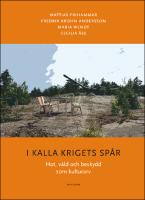I kalla krigets spår
Hot, våld och beskydd som kulturarv
| dc.contributor.author | Frihammar, Mattias | |
| dc.contributor.author | Krohn Andersson, Fredrik | |
| dc.contributor.author | Wendt, Maria | |
| dc.contributor.author | Åse, Cecilia | |
| dc.date.accessioned | 2023-06-05T13:54:41Z | |
| dc.date.available | 2023-06-05T13:54:41Z | |
| dc.date.issued | 2023 | |
| dc.identifier.uri | https://library.oapen.org/handle/20.500.12657/63210 | |
| dc.description.abstract | Cultural heritage is not just something from the past, but always also reflects contemporary needs and desires. In the Traces of the Cold War describes the making of a diverse and innovative Swedish military heritage. The book shows how memories and material remains from a period characterized by fear and geopolitical tensions are infused with new meanings when bunkers, decommissioned military facilities and technology are transformed into luxury housing, attractive tourist destinations and museum exhibitions. Through field-visits to military heritage sites across Sweden, the authors examine what material objects, narratives and emotions that today represent the Cold War. These examinations show how military structures and equipment from a time associated with threat and danger become captivating elements of the cultural heritage, while also communicating specific ideas regarding security and protection. In the Traces of the Cold War takes a novel approach to cultural heritage by relating collective memory-making to security policy. Based on theoretical perspectives from critical heritage studies (CHS) and feminist international relations (IR), the analysis focuses on constructions of national belonging and underlines the role of gender and sexuality in narrations of security and protection. In a democracy, the subject of military violence must always be a matter of ethical and political conversations. Setting out from this assumption, the authors critically discuss how Cold War heritagisation produces militarization as “natural” and necessary. The book invites reflection on how history is written as well as on what the requirements are for a safe and secure society. In the Traces of the Cold War presents the results from an interdisciplinary research project. The authors are all researchers at Stockholm University and have written the book together. | en_US |
| dc.language | Swedish | en_US |
| dc.subject.classification | thema EDItEUR::J Society and Social Sciences::JH Sociology and anthropology::JHM Anthropology::JHMC Social and cultural anthropology | en_US |
| dc.subject.classification | thema EDItEUR::G Reference, Information and Interdisciplinary subjects::GL Library and information sciences / Museology::GLZ Museology and heritage studies | en_US |
| dc.subject.classification | thema EDItEUR::A The Arts::AM Architecture::AMX History of architecture | en_US |
| dc.subject.classification | thema EDItEUR::J Society and Social Sciences::JP Politics and government::JPS International relations | en_US |
| dc.subject.classification | thema EDItEUR::J Society and Social Sciences::JP Politics and government::JPA Political science and theory | en_US |
| dc.subject.classification | thema EDItEUR::J Society and Social Sciences::JB Society and culture: general::JBS Social groups, communities and identities::JBSF Gender studies, gender groups | en_US |
| dc.subject.other | Bunkers; Bunkrar; Security politics; Säkerhetspolitik; Gender; Genus; Military threat; Militärt hot; Military Heritage; Militära kulturarv; Cold War; Kalla kriget | en_US |
| dc.title | I kalla krigets spår | en_US |
| dc.title.alternative | Hot, våld och beskydd som kulturarv | en_US |
| dc.type | book | |
| oapen.identifier.doi | 10.22188/kriterium.45 | en_US |
| oapen.relation.isPublishedBy | 7b034f4a-b816-4718-88ac-63b24c8e4b24 | en_US |
| oapen.relation.isbn | 9789170614293 | en_US |
| oapen.pages | 244 | en_US |
| oapen.place.publication | Lund | en_US |

